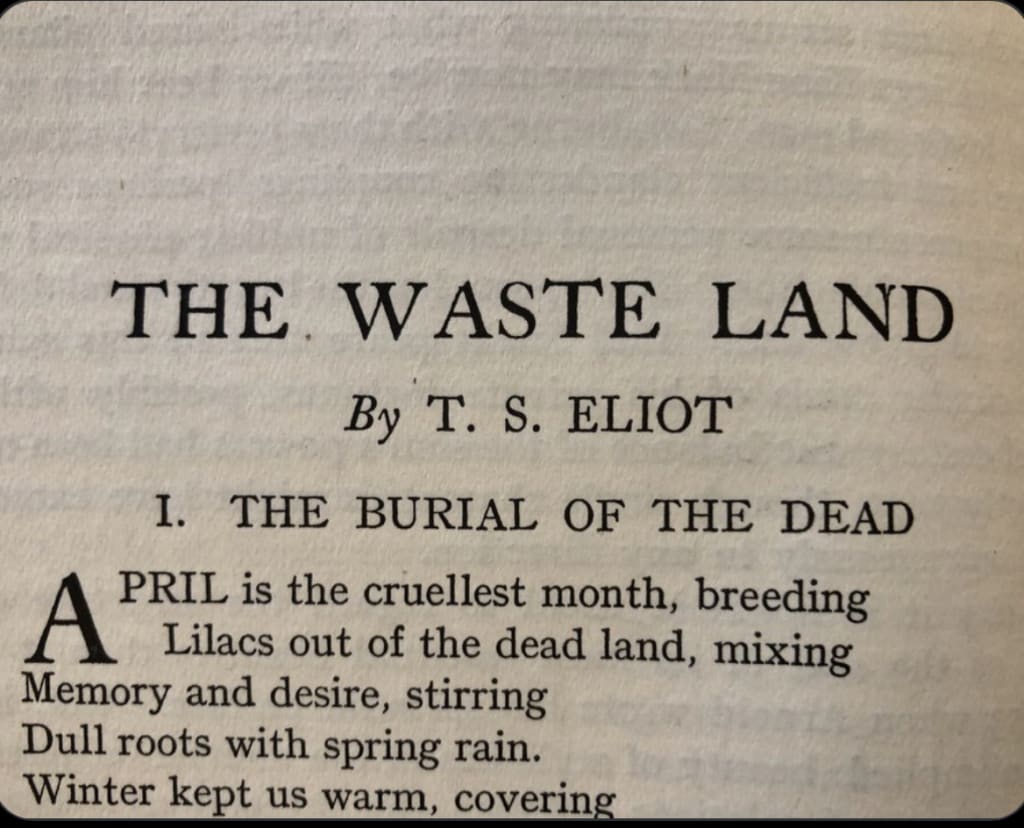
Ezra Pound weighed in on the modernist movement and promoted artists like T.S. Eliot. In The Wasteland edited by Pound, there’s a collation between infertility, nihilism, and human consciousness. In The Wasteland poetic form is a monologue. Interestingly the poem is written from multiple points of view. This type of literary device used is fragmentation. This illustrates how fragile human minds are because of WWI. The tone of the poem could be defined as
nihilism Webster says is “a viewpoint that traditional values and beliefs are unfounded, and that existence is senseless and useless.” Between the title The Wasteland and the main themes of infertility and human consciousness.
The religious undertones are present based on how two of the sections are titled “THE BURIAL OF THE DEAD and THE FIRE SERMON”. The main character in this poem is The Fisher King alludes to the Holy Grail myth. Pound had a hand in shaping the genre of modernist
ideals, in his contemporaries like Eliot. Pound’s belief is “Turn away from romantic and symbolist poetic diction” (Domestico and Lewis). This could be viewed as a symbolic flow of human language inflected in the how diction of modernist form.
In addition, in “The Wasteland” by Elliot, the poem itself is “the single most influential piece of poetry in modern times" (Poets.org). As with any revision or collaboration, sometimes the original content is left out of the final product. “Pound's relation to the cultural divide differed from Eliot's” (Chinitz 242). This raises the question if the narrator’s voice shifts throughout the piece or is cohesive over a singular point of view. How different would the poem look if Elliot revised the passages Pound deemed unnecessary? If Pound had not edited The
Wasteland, would it still be considered the most influential literary work? I would say that Pound shifted the use of figurative language to more pictorial. He takes out all the flowery
language filler in place of the directness of imagism. Imagism refers to “the use of succinct language in poetry, excluding words that do not “contribute to the presentation” (Domestico and Lewis). I would say that Eliot implements both imagism and poetic diction throughout the piece. With the allusions in the entire poem. In the first line of the poem, “APRIL is the cruelest
month.” This is an example of an allusion from the prologue of The Canterbury Tales. The next allusion that is made in this literary piece is, "Musing upon the king my brother’s wreck," This can allude to Shakespeare’s The Tempest. The section “Fire Sermon” alludes to a speech given by Budda. Though this is an example of irony because the motif in this section is about lust.
In line 60, “Unreal City” is an allusion to Charles Baudelaire a 19th-century poet. Lastly, “To Carthage then I came. Burning burning burning burning.” This Alludes to Dido Queen of Carthage ruin and St. Augustine. Furthermore, it’s a good example of a metaphor. There are also poetic devices in the first stanza of the poem. The first is consonance “ing “sounds in the end rhyme. Also, “forgetful snow” is an example of personification. In the lines, “Your shadow at morning striding behind you Or your shadow at evening rising to meet you;” This is an example of the literary device parallelism. Parallelism is defined as, a rhetorical component where ideas are arranged and balanced in one element. In this case, the parallel would be the term “ shadow”.
As far as the human consciousness the theme of religious or antireligious feelings expressed in the poem culturally varies from Christianity, Hinduism, Buddhism, and ritual practices in each section. Lastly, there is a spiritual reference to tarot cards in lines 51-55:
“Here is the man with three staves, and here the Wheel,
And here is the one-eyed merchant, and this card,
Which is blank, is something he carries on his back,
Which I am forbidden to see. I do not find
The Hanged Man. Fear death by water.”
In conclusion, bringing to light all these social and ritual practices in a nihilist light. The Wasteland by Eliot helps the reader understand the significant events in our society that influenced his modernist literary piece. As well as the psychological standpoint of WWI through his poetic vision.

Works Cited:
Chinitz, David. “T. S. Eliot and the Cultural Divide.” PMLA 10.2 (1995): 236-247. Print.
Domestico, Anthony, and Pericles Lewis. “Biography: Ezra Pound.” The Modernism Lab. Yale University, 2010. Web. 18 August 2012.
“Nihilism.” Merriam-Webster.com Dictionary, Merriam-Webster, https://www.merriam-webster.com/dictionary/nihilism. Accessed 29 May. 2023.
About the Creator
Saroyan Coles
I want to empower others with my writing. I have always dreamed of seeing my name, on something.






Comments
There are no comments for this story
Be the first to respond and start the conversation.